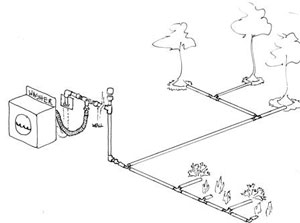
In California, under Health and Safety Code § 17922.12, graywater is defined as “untreated wastewater that has not been contaminated by any toilet discharge, has not been affected by infectious, contaminated, or unhealthy bodily wastes, and does not present a threat from contamination by unhealthful processing, manufacturing, or operating wastes. Graywater includes, but is not limited to, wastewater from bathtubs, showers, bathroom washbasins, clothes washing machines, and laundry tubs, but does not include wastewater from kitchen sinks or dishwashers.”
Currently, a permit is no longer required for the installation of a single-family or two-family residential graywater irrigation systems from a simple clothes washing graywater system as long as it does not require cutting of the existing plumbing piping.
All other systems require a construction permit prior to erection, retrofitting, construction and installation as stated in the actual code. The full text of these standards can be viewed at the California Department of Housing and Community Development (HCD) Division of Codes and Standards website, http://www.hcd.ca.gov/codes. Because these regulations may change at any time, always check with HCD and local enforcement agencies before developing plans for or installing a graywater system. Cities and counties can impose stricter guidelines than the state, so homeowners interested in installing graywater systems should contact their local jurisdiction for specific regulations concerning graywater handling and use.
Laundry-to-landscape graywater systems are relatively simple to install and are inexpensive. The hose exiting the clothes washing machine is attached to a valve that separates graywater from water destined for the sewer. The graywater is diverted through a 1-inch main irrigation line with ½-inch tubing outlets placed throughout the landscape terminating in a valve box set in what is termed a “mulch basin” that surrounds plants being watered (see below). The washing machine pump distributes water directly to the landscape with no filter.A vacuum break or backflow prevention device may also be needed. Keep in mind that salt-free and boron-free liquid laundry detergents should be used for irrigating the landscape. In addition, chlorine bleach should be avoided.
Attached Files: